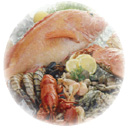|
 |
February 2007 |
(Also available in PDF, 473 KB, and Spanish)

Each year, millions of Americans have allergic reactions to food. Although most food allergies cause relatively mild and minor symptoms, some food allergies can cause severe reactions, and may even be life-threatening.
There is no cure for food allergies. Strict avoidance of food allergens — and early recognition and management of allergic reactions to food — are important measures to prevent serious health consequences.
To help Americans avoid the health risks posed by food allergens, Congress passed the Food Allergen Labeling and Consumer Protection Act of 2004. The law applies to all foods regulated by FDA, both domestic and imported, that were labeled on or after January 1, 2006. (FDA regulates all foods except meat, poultry, and certain egg products.)
Before this law, the labels of foods made from two or more ingredients were required to list all ingredients by their common, or usual, names. The names of some ingredients, however, do not clearly identify their source.
Now, the labels must clearly identify the source of all ingredients that are — or are derived from — the eight most common food allergens.
As a result, food labels will help allergic consumers to identify offending foods or ingredients so they can more easily avoid them.
Food products labeled before January 1, 2006 were not required to be re-labeled under the law of 2004. However, these foods may still be on store shelves — so be sure to take that into consideration while shopping, and always use special care when reading labels.


While more than 160 foods can cause allergic reactions in people with food allergies, the law identifies the eight most common allergenic foods. These foods account for 90 percent of food allergic reactions, and are the food sources from which many other ingredients are derived.
| The eight foods identified by the law are: |
|---|
|
These eight foods, and any ingredient that contains protein derived from one or more of them, are designated as "major food allergens" by the law.
The law requires that food labels identify the food source of all major food allergens. Unless the food source of a major food allergen is part of the ingredient's common or usual name (or is already identified in the ingredient list), it must be included in one of two ways.
The name of the food source of a major food allergen must appear:
– OR –
The appearance of symptoms (see Know the Symptoms at right) after eating food may be a sign of a food allergy. The food(s) that caused these symptoms should be avoided, and the affected person, should contact a doctor or health care provider for appropriate testing and evaluation.
Persons found to have a food allergy should learn to read labels and avoid the offending foods. They should also learn, in case of accidental ingestion, to recognize the early symptoms of an allergic reaction, and be properly educated on — and armed with — appropriate treatment measures.
Persons with a known food allergy who begin experiencing symptoms while, or after, eating a food should initiate treatment immediately, and go to a nearby emergency room if symptoms progress.


Symptoms of food allergies typically appear from within a few minutes to two hours after a person has eaten the food to which he or she is allergic.
| Allergic reactions can include: | |
|---|---|
|
|
About Other Allergens
Persons may still be allergic to — and have serious reactions to — foods other
than the eight foods identified by the law. So, always be sure to read the
food label's ingredient list carefully to avoid the food allergens in question.

Initially mild symptoms that occur after ingesting a food allergen are not always a measure of mild severity. In fact, if not treated promptly, these symptoms can become more serious in a very short amount of time, and could lead to anaphylaxis. See The Hard Facts at left.
Following ingestion of a food allergen(s), a person with food allergies can experience a severe, life-threatening allergic reaction called anaphylaxis.
This can lead to:
Each year in the U.S., it is estimated that anaphylaxis to food results in:
Prompt administration of epinephrine by autoinjector (e.g., Epi-pen) during early symptoms of anaphylaxis may help prevent these serious consequences.